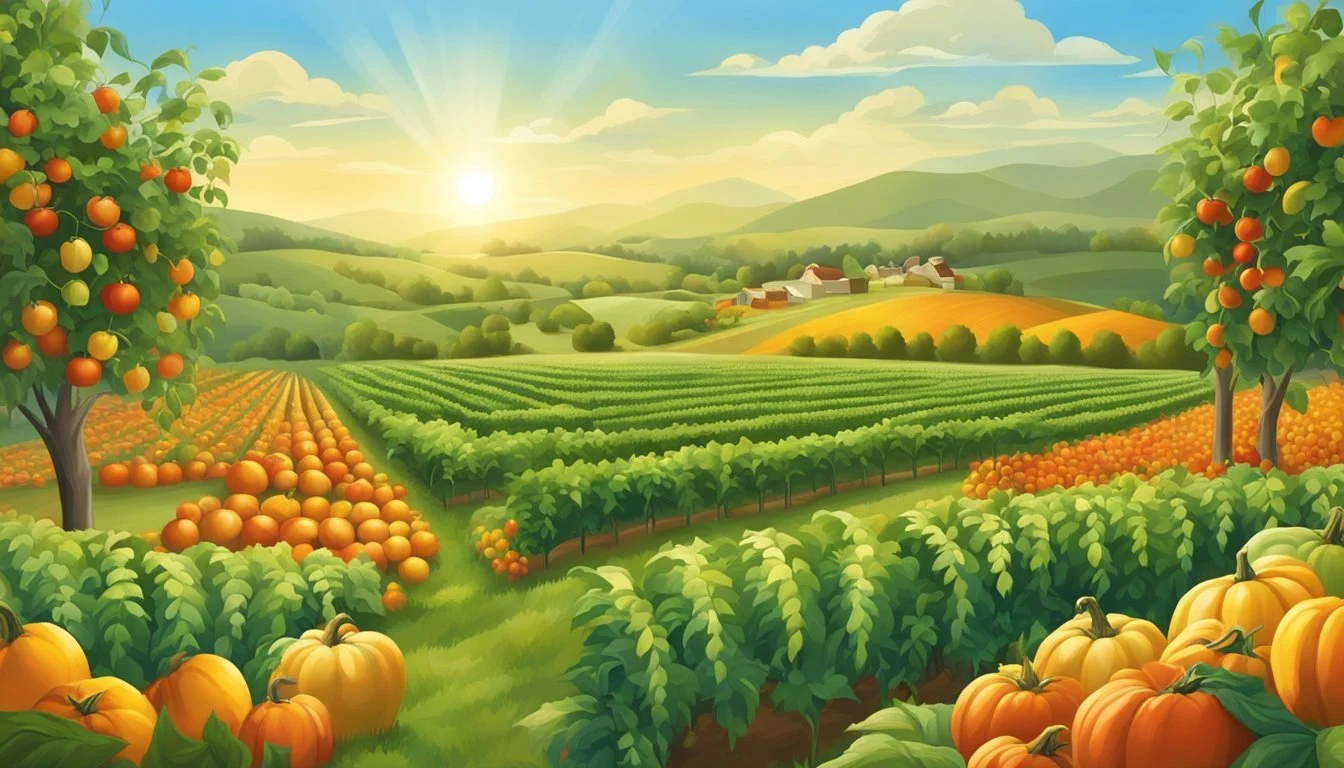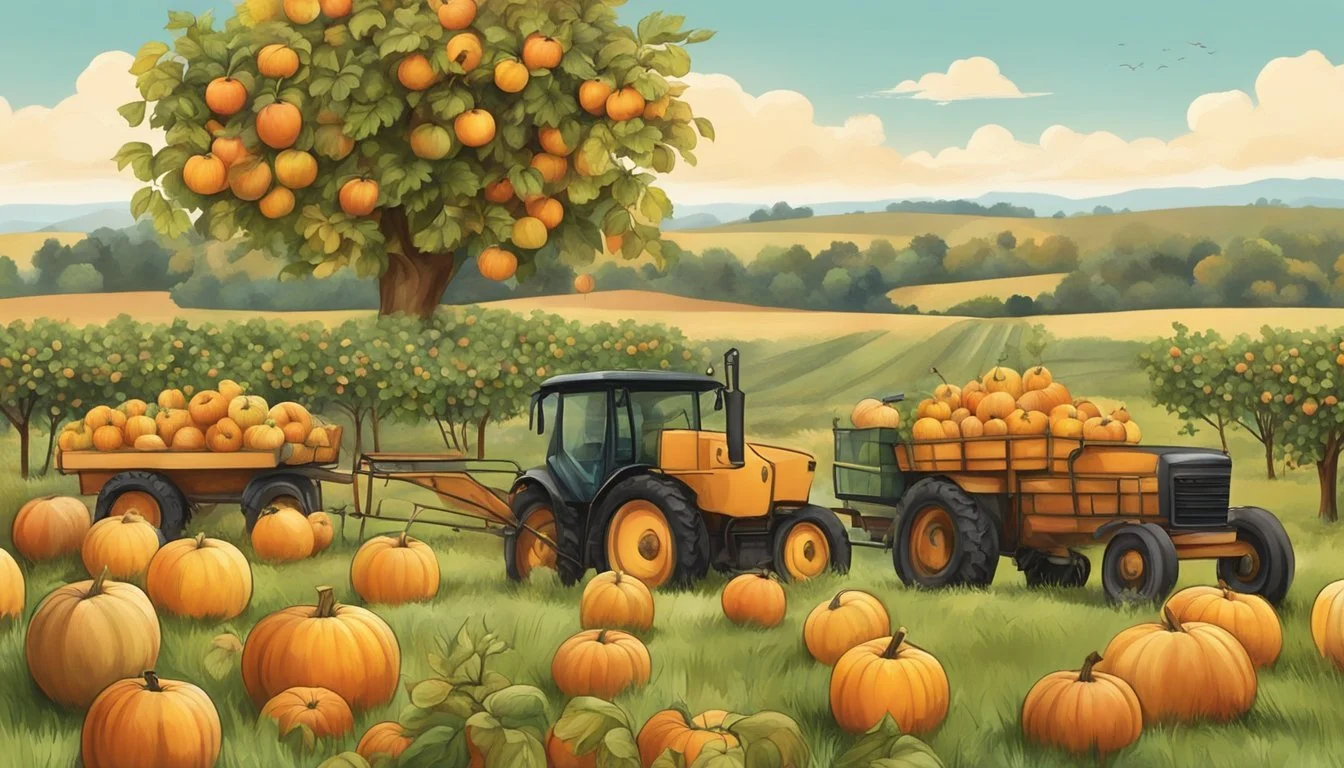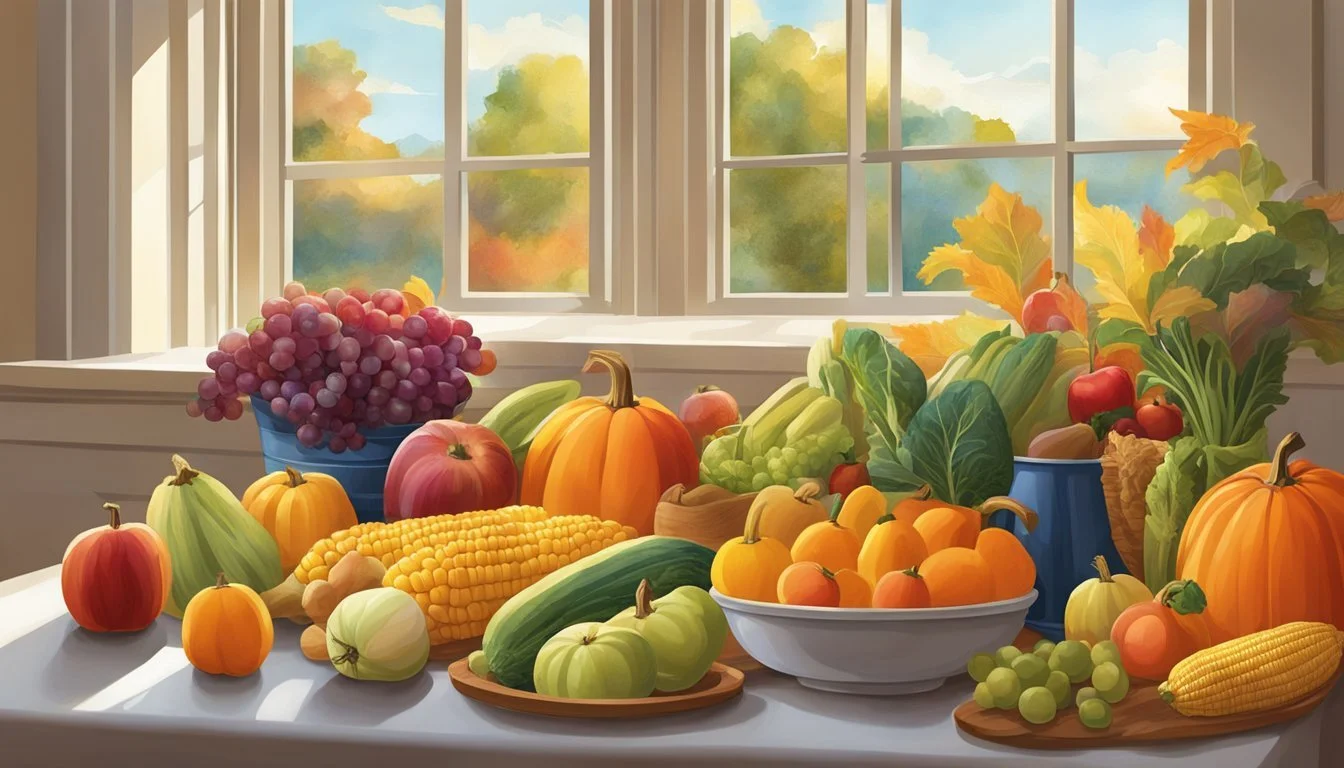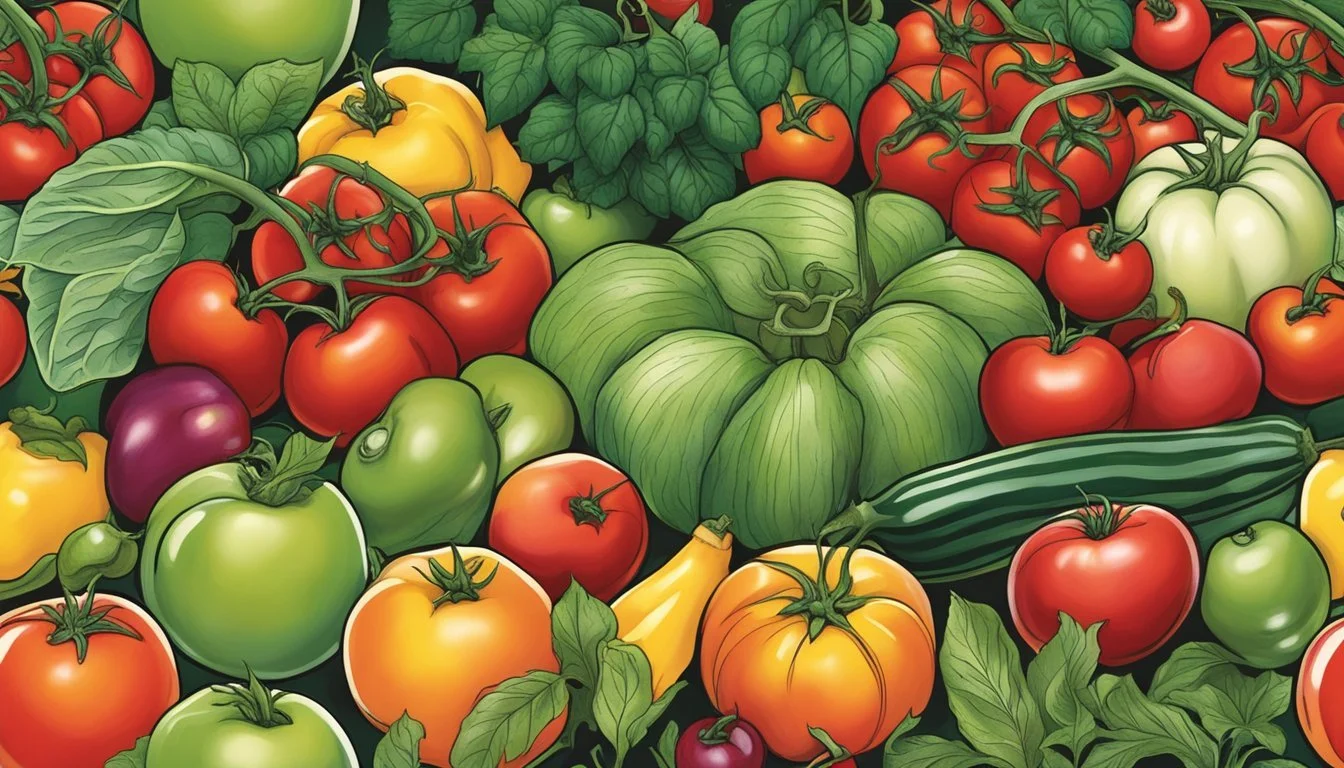Rhode Island Seasonal Fruit & Vegetables in September
A Fresh Guide to Autumnal Produce
This Article is Part of our Rhode Island Seasonal Fruit & Veg Calendar
As the summer sun wanes and autumn whispers into Rhode Island, September brings a new chapter in the state’s agricultural calendar. This is the time of year when the harvest unfolds in a colorful array, offering a bounty of fruits and vegetables that capture the essence of the season. The local produce not only reflects the state's rich farming heritage but also underscores the importance of eating foods that are grown close to home and harvested at their peak for flavor and nutritional value.
The mild climate of Rhode Island during September is particularly conducive to growing a variety of produce. Fruit aficionados can revel in the last of the summer's berries while also enjoying the first crisp apples and sweet pears of the approaching fall. The vegetable selection is equally robust, with staples like tomatoes and corn continuing their season, alongside emerging fall favorites such as pumpkins and squashes.
Farmers' markets and roadside stands across the state become vibrant showcases of Rhode Island’s September offerings. These local hubs are not just places to purchase fresh fruit and vegetables; they are also spaces where community ties are strengthened and where the rhythms of nature are honored in daily life. The commitment to local agriculture enables Rhode Islanders to eat seasonally and supports the local economy, ensuring the preservation of the state’s farming culture for future generations.
Overview of Rhode Island's Growing Seasons
Rhode Island's growing seasons reflect its temperate climate, with planting and harvest times intricately tied to weather patterns. As one navigates through the calendar, understanding the growing cycle is crucial, especially in the transitional months of September and October where summer gives way to fall.
Understanding the Growing Calendar
The growing calendar in Rhode Island is governed by the frost dates, typically around May 15 for the last frost of spring and October 15 for the first frost of fall. Gardeners and farmers must pay close attention to these dates, as they significantly affect the viability of planting and harvesting crops. For instance, in September, the weather is still warm enough to support the growth of many summer vegetables while also cool enough in the evenings to accommodate early fall varieties.
Key Crops before First Fall Frost:
Vegetables: tomatoes, peppers, green beans, cucumbers, zucchini (What wine goes well with zucchini?), and summer squash
Herbs: basil, cilantro, parsley, and dill
Fruits: apples, peaches, and pears
Sept. Tasks:
Harvesting summer crops
Planting fall vegetables like kale and spinach
Preparing for first frost in October
Transition From Summer to Fall
As Rhode Island moves from the summer months into fall, the weather transitions, with average temperatures beginning to dip. Gardeners must monitor the weather closely during September, anticipating cooler nights that signal the onset of autumn. This period requires preparations for the cooler season, such as planting frost-tolerant crops and beginning to harvest hardier fruits.
Autumn Planting and Harvesting:
Vegetables for Fall Planting: beets, carrots, lettuce, and other greens suited for cooler weather
Harvesting: Beginning of apple and pumpkin harvest seasons
The transition also affects the soil, as the summer's heat can leave it dry; hence, soil preparation and moisture regulation become even more important to ensure a successful fall season. Gardeners might also initiate "hardening off" of transplants, gradually exposing them to cooler outdoor conditions to fortify them against the coming colder months.
Seasonal Fruit in Rhode Island
In September, Rhode Island's orchards and farms offer a bountiful harvest, prominently featuring apples, an array of berries, and stone fruits that are ripe for picking.
Apples
Rhode Island is home to a variety of apples come September. They range from the sweet Honeycrisp to the tart Macoun. Orchards usually commence apple-picking season during this month, providing an opportunity for locals and visitors to savor freshly picked varieties straight from the trees.
Types of Apples:
Honeycrisp
Macoun
Gala
McIntosh
Berries
While the peak season for most berries has passed, some farms may still offer late harvest raspberries or blackberries (how long do blackberries last?). These berries are often smaller but pack concentrated flavors, perfect for jams and desserts.
Late-Season Berries:
Raspberries (late varieties)
Blackberries (late varieties)
Stone Fruits
As the stone fruit season ends, one can still find some late varieties of peaches and plums. These fruits are known for their succulent flesh and are often at their peak of sweetness in the early days of September.
Available Stone Fruits:
Peaches (late-season varieties)
Plums (late-season varieties)
Pears, another local delight, are often picked beginning in September and can be found fresh in local markets.
Seasonal Vegetables in Rhode Island
Rhode Island's September harvest offers a rich tapestry of vegetables, bursting with flavors. Shoppers can fill their baskets with everything from leafy greens to hearty root vegetables, and the vibrant colors of nightshades and squashes.
Leafy Greens and Salad Crops
September in Rhode Island is an excellent time for salad enthusiasts. Vegetables like kale, spinach, and lettuce thrive during this season, providing a fresh base for any salad. Additionally, arugula (how long does arugula last?) and chard offer a peppery kick and a variety of textures for diverse dishes.
Kale
Varieties: Curly, Red Russian, Lacinato
Spinach
Notable for: High levels of iron and folate
Lettuce
Types: Butterhead, Romaine, Leaf
Arugula
Chard
Note: Rich in vitamins A, C, and K
Root Vegetables
Root vegetables are a cornerstone of the fall diet in Rhode Island, and September sees the harvest of many nutritious and comforting varieties. Staple crops such as potatoes and carrots are readily available, while parsnips make a seasonal debut, bringing a sweet and earthy depth to meals.
Potatoes
Useful for: Mashing, roasting, boiling
Carrots
High in beta-carotene, supporting eye health
Parsnips
Pair well with: Cinnamon, nutmeg (how long does nutmeg last?), or ginger for spiced dishes
Radishes
Varieties: Daikon, Red Globe
Onions
Nightshades and Squashes
The end of summer and beginning of fall is the prime time for nightshades like eggplant (What wine goes well with eggplant?), tomatoes, and peppers, all ripe and full of rich flavors. Meanwhile, squash enters the scene in various forms including pumpkins, zucchini, and summer squash—each providing a unique taste and texture to Rhode Island's culinary landscape.
Eggplant
Preparation: Grilled, baked, or as part of a ratatouille (What wine goes well with ratatouille?)
Tomatoes
From heirloom varieties to cherry tomatoes
Peppers
Ranging from sweet bells to spicy jalapeños
Pumpkins
Ready for: Pies, soups, or as decoration
Squash
Types: Butternut, Spaghetti, Acorn
Zucchini
Perfect for: Sautéing, breads, and muffins
Summer Squash
Versatile in: Casseroles, stir-fries, and as a side dish
Harvesting and Picking Tips
In Rhode Island, September heralds the time for an abundant harvest of fruits and vegetables. To ensure the freshest produce and best flavor, it's important for one to follow specific techniques and timing for picking and harvesting.
Best Practices for Fruit Picking
When picking fruit, one must look for signs of peak ripeness that indicate the best flavor and quality. Each fruit has its own cues, such as color, firmness, and ease of release from the stem.
Apples: Pick when the color is fully developed and the apple separates easily from the branch with a twisting pull.
Pears: Harvest when the fruit is still firm but the color has deepened. Pears ripen off the tree, so picking before over-softening is crucial.
Grapes: Ready when they are fully colored and the sweetness is palpable through a taste test.
To ensure minimal damage, they should harvest fruits using gentle hands and place them carefully into containers.
Ideal Times for Vegetable Harvest
Vegetables harvested at the right time of day and at the correct stage of development will have the best longevity and taste.
Root vegetables (carrots, beets): Harvest these when they are medium-sized for the best texture and flavor, usually in the morning when the soil is cool.
Leafy greens (lettuce, kale): Pick early in the day when the leaves are most hydrated for maximum crispness.
Tomatoes: Wait until they are fully colored and slightly soft to the touch, indicating ripeness.
Enthusiasts should note that the morning, when produce is still cool from the night, is often the best time for harvesting as the heat later in the day can stress plants and reduce quality.
Local Farming and Markets
In September, Rhode Island’s agricultural sector thrives, supplying a diverse array of local produce through various markets and farming initiatives.
Farm to Table
Rhode Island champions the farm-to-table movement, ensuring state residents have access to fresh, nutritious crops. Farmers across the state harvest a variety of produce in September, including late-summer vegetables and the first of autumn's offerings. This bounty finds its way to consumers' plates through direct market channels such as farmers markets. One notable example is the farmers market located outside the Algonquin House, which is celebrated for a variety of Asian and African vegetables.
Community Supported Agriculture
Community Supported Agriculture (CSA) programs in Rhode Island strengthen the relationship between local farms and the community. Through CSA, residents purchase a share of a farm's crop at the start of the growing season, taking a stake in the farm's yield. This model provides upfront capital for farmers to manage their operations and, in return, shareholders receive regular allotments of the farm's produce. This method ensures that the local economy benefits from the support of its members, and the diversity of available crops is maintained throughout the state.
Preparing Seasonal Produce
In September, Rhode Island's harvest offers a bountiful selection of fruits and vegetables. This section provides practical advice on how to store and preserve these seasonal offerings, as well as ideas and tips to maximize their flavors through various recipes and cooking methods.
Storage and Preservation
Proper storage and preservation are essential to maintain the freshness and nutritional value of the produce.
Apples: Store in a cool, dark place. Apples like the Honeycrisp or Gala variety are crisp and juicy - perfect for eating fresh or for storage. If preserved, they can be used for sauces and pies.
Pears: Keep at room temperature until ripe; then refrigerate. Pears can range from sweet to tart, and many can be canned or dried for later use.
Tomatoes: Store at room temperature away from direct sunlight to maintain their juicy texture. For long-term storage, consider canning or making sauces.
Preservation methods include canning, freezing, drying, and pickling, enabling one to enjoy these flavors well beyond their seasons.
Recipe Ideas and Cooking Tips
When cooking with seasonal produce, one can create a range of tasty and healthy dishes.
Apples and Pears: Incorporate slices into salads for a sweet and crisp contrast or bake into desserts for a comforting fall treat.
Recipe Tip: A classic apple crisp combines sliced apples, cinnamon, sugar, and a buttery oat topping, baked until golden and bubbling.
Tomatoes: Utilize tomatoes in sauces, sandwiches, and salads.
Cooking Tip: For a simple sauce, roast tomatoes with garlic, olive oil, and herbs until caramelized then blend until smooth.
Each fruit and vegetable in September's seasonal selection offers its unique flavor profile, allowing for endless culinary exploration.
Health and Nutrition Benefits
Eating fruits and vegetables that are in season in Rhode Island during September provides numerous health and nutrition benefits. Seasonal eating supports a diet richer in nutrients, as fruits and vegetables are often at their peak in both flavor and nutritional value. Here are some key benefits:
Nutritional Value: Seasonal produce is typically harvested at the right time for consumption, which means it can contain more vitamins, minerals, and antioxidants compared to out-of-season or stored produce.
Healthy Choices: With a variety of seasonal options available, consumers are more likely to diversify their diet. A varied diet ensures a broader intake of essential nutrients, supporting overall health.
Dietary Recommendations: Incorporating fresh seasonal fruits and vegetables helps in meeting dietary guidelines, which recommend a specific daily intake of these food groups.
Seasonal Eating: Engaging in seasonal eating is not only nutritionally beneficial but may also introduce consumers to new flavors and recipes, encouraging a more enjoyable and health-conscious diet.
The table below highlights some seasonal fruits and vegetables in Rhode Island during September and their health benefits:
Produce Health Benefits Apples Fiber-rich, supports heart health Pears Good source of vitamin C Tomatoes High in lycopene, an antioxidant Zucchini Low calorie, high in potassium Kale Dense in nutrients, especially vitamins K, A, and C
Including these seasonal offerings in one's diet can contribute to improved immunity, reduced inflammation, and overall better health.
Rhode Island Food Events and Festivals
Rhode Island's culinary scene comes alive with events and festivals that bring the community together in celebration of local food and traditions. September, with its bountiful harvest, often serves as a backdrop for such vibrant gatherings.
Food Festivals in September:
Rhode Island Seafood Festival brings the catch of the day to the forefront, showcasing the state's rich seafood offerings, typically held at India Point Park in Providence.
Harvest Fair at Norman Bird Sanctuary offers a family-friendly environment with local crafts and foods, celebrating the season's bounty in Middletown.
In addition to specific festivals, farmers' markets across Rhode Island offer fresh, seasonal produce and handcrafted food items. September sees an abundance of apples, pumpkins, and corn, amongst other local produce.
Weekly Community Events:
Local farmers' markets are open during the week, featuring cooking demonstrations and often live music, enhancing the community's weekly routines.
Rhode Island honors its food history and culture not just through these events but also through regular culinary tours and tastings which may fall in September. Such activities invite locals and tourists alike to explore Rhode Island's diverse food landscape.
Residents often take pride in their state's culinary offerings, as September's events highlight seasonal ingredients and local culinary arts. Visitors should expect a clear taste of Rhode Island's food heritage through these events and festivals, woven into the fabric of the Ocean State's identity.










